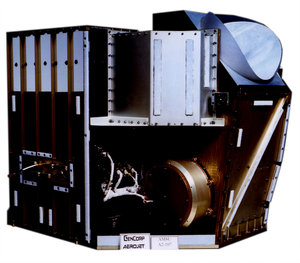ASCAT performance
The following table shows the current engineering performance, the nominal mode requirements and the high-resolution mode goals for the first flight model instrument.
| Performance Parameter | Unit | Nominal mode requirement | Nominal mode budget | High-res mode goal | High-res mode budget |
|---|---|---|---|---|---|
| Swath width | |||||
| Full performance | km | 500 | 500 | 500 | 500 |
| Reduced performance | km | 550 | 550 | 550 | 550 |
| Swath length | km | Continuous | Yes | Continuous | Yes |
| Spatial resolution | km | <50.0 | <50.0 | <25.0 | <34 |
| Spectral resolution | km-¹ | >0.0182 | >0.0183 | >0.0364 | >0.026 |
| Radiometric resolution | |||||
| High upwind (24 m/s) | % | <3.0 | <2.7 | <6.0 | 5.5 |
| Near low x-wind (4 m/s) | % | <3.0 | <2.8 | <7.4 | 5.7 |
| Far low x-wind (4 m/s) | % | <10.0 | <5.3 | <16.5 | 11.4 |
| Radiometric accuracy | dBpp | <0.57 | <0.47 | <0.57 | 0.48 |
| Interbeam stability | dBpp | <0.46 | <0.47 | <0.46 | 0.49 |
| Aliasing contribution | % | <1.0 | <0.02 | <1.0 | <0.02 |
| Ambiguity contribution | |||||
| Near swath | % | <1.2 | 0.3 | <1.2 | 0.3 |
| Far swath | % | <4.6 | 3.7 | <4.6 | 3.7 |
| Cross-polarisation | dB | >15.0 | >37.9 | >15.0 | >37.9 |
Terminology
Swath width. The final product is specified over the full performance swath, but the data will be collected over the reduced performance width. The width refers to each single swath.
Spatial resolution is the width of the system Impulse Response Function (IRF) in response to a point target across- and along-track, where the intensity reaches 50% of the peak value.
Spectral resolution is the 3 dB width of the overall system Modulation Transfer Function (MTF). This is the Fourier transform of the IRF.
Radiometric resolution is the ability to distinguish between different values of radar backscatter. It describes the uncertainty in the scattering coefficient estimate due to speckle and thermal noise. It is a function of the instrument signal-to-noise ratio, and hence of the wind speed.
Radiometric accuracy describes the uncertainty in the scattering coefficient estimate when the effects of speckle and thermal noise are neglected.
Interbeam stability is the relative difference between the scattering coefficient estimates of any two beams when looking at an identical target, neglecting the effects of speckle and thermal noise.
The aliasing contribution is the disturbance to a scattering coefficient estimate due to a non-uniform spatial distribution of the reflectivity field.
Ambiguity contribution describes the amount of unwanted energy contributing to the scattering coefficient estimate. It is a function of swath position.
Cross-polarisation describes the ratio of the electrical field vector in orthogonal planes, the first contains the satellite local vertical and the direction of propagation, whilst the second contains only the direction of propagation.


















